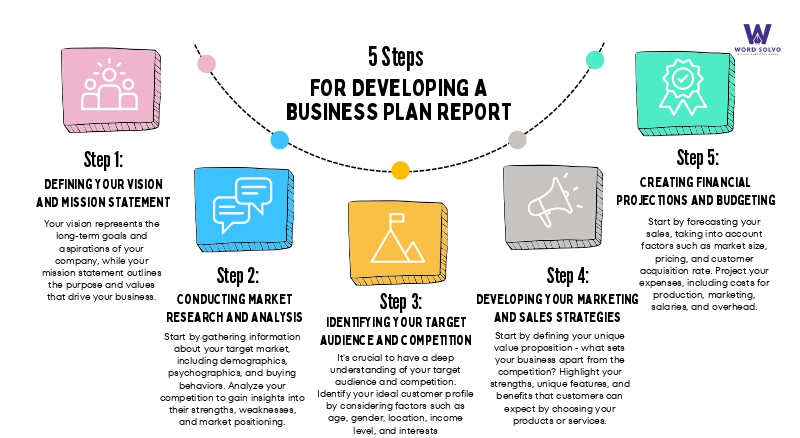Crafting a business plan is like building a roadmap to success. But the journey from vision to execution can be challenging without a solid strategy in place. In this article, we'll explore five step-by-step strategies that will help you develop a winning business plan report.
First, we'll begin with thorough market research. Understanding your industry, target market, and competitors is crucial for identifying opportunities and mitigating risks. Next, we'll move on to defining your business' unique value proposition. What sets you apart from the competition? Highlighting your strengths and differentiating factors will attract investors and customers.
Then, we'll dive into creating a comprehensive financial plan. This includes forecasting sales, projecting expenses, and setting realistic goals. Additionally, we'll discuss the importance of establishing a strong marketing and sales strategy, outlining how you will reach and engage your target audience.
Lastly, we'll emphasize the significance of regularly reviewing and revising your business plan as your company evolves and faces new challenges.
With these five strategies in your toolkit, you'll be well-equipped to transform your vision into a well-executed business plan. Let's get started!
Importance of a Comprehensive Business Plan
A comprehensive business plan serves as a blueprint for your company's success. It outlines your goals, objectives, and strategies, providing a clear roadmap for achieving them. Without a well-crafted plan, your business may lack direction and struggle to attract investors or secure financing. A business plan also helps you identify potential obstacles and devise strategies to overcome them. It serves as a communication tool that can be shared with stakeholders, employees, and potential partners, aligning everyone towards a common vision. A well-developed business plan can significantly increase your chances of success and help you navigate the challenges that lie ahead.

Step 1: Defining your Vision and Mission Statement
The first step in developing a winning business plan is to define your vision and mission statement. Your vision represents the long-term goals and aspirations of your company, while your mission statement outlines the purpose and values that drive your business. These statements serve as guiding principles and set the foundation for your business plan. When crafting your vision and mission statement, it's important to be clear, concise, and specific. Your vision and mission should inspire and motivate both your team and potential investors, making them believe in the potential of your business.
Step 2: Conducting Market Research and Analysis
Thorough market research is essential for understanding the industry landscape, identifying market trends, and assessing the potential demand for your products or services. Start by gathering information about your target market, including demographics, psychographics, and buying behaviors. Analyze your competition to gain insights into their strengths, weaknesses, and market positioning. This will help you identify opportunities for differentiation and competitive advantage. Additionally, research industry trends, economic factors, and regulatory requirements that may impact your business. By conducting comprehensive market research, you'll be equipped with the knowledge needed to make informed decisions and develop a solid business plan.
Step 3: Identifying your Target Audience and Competition
In order to develop an effective business plan, it's crucial to have a deep understanding of your target audience and competition. Identify your ideal customer profile by considering factors such as age, gender, location, income level, and interests. This will help you tailor your products or services to meet their specific needs and preferences. Additionally, analyze your competition to understand their offerings, pricing, marketing strategies, and customer base. By identifying your key competitors, you can position your business in a way that sets you apart and appeals to your target audience. Understanding your target audience and competition is vital for developing a successful business plan that will attract customers and drive growth.
Step 4: Developing your Marketing and Sales Strategies
A well-executed marketing and sales strategy is essential for reaching and engaging your target audience. Start by defining your unique value proposition - what sets your business apart from the competition? Highlight your strengths, unique features, and benefits that customers can expect by choosing your products or services. Develop a marketing plan that includes channels, tactics, and messaging that will effectively reach your target audience. Consider both traditional and digital marketing strategies, such as social media advertising, content marketing, email marketing, and search engine optimization. Additionally, outline your sales strategies and tactics, including pricing, distribution channels, and sales team structure. By developing a comprehensive marketing and sales strategy, you'll be able to effectively promote your products or services and drive revenue growth.
Step 5: Creating Financial Projections and Budgeting
Creating a comprehensive financial plan is crucial for demonstrating the financial viability of your business and attracting potential investors or lenders. Start by forecasting your sales, taking into account factors such as market size, pricing, and customer acquisition rate. Project your expenses, including costs for production, marketing, salaries, and overhead. It's important to be realistic and conservative when estimating your revenues and expenses. Additionally, develop a cash flow projection to ensure you have enough working capital to cover your expenses and sustain your business. Finally, create a budget that aligns with your financial projections. This will help you allocate resources effectively and track your progress against your financial goals.
Putting it all Together: Writing your Business Plan Report
Now that you have completed the necessary research and strategy development, it's time to put it all together and write your business plan report. Start with an executive summary that provides an overview of your business, mission, and vision. Then, dive into the sections we discussed earlier, including your market analysis, target audience, competition, marketing and sales strategies, and financial projections. Be sure to include supporting data, charts, and graphs to enhance the clarity and credibility of your business plan. Keep your writing clear, concise, and focused on the key points. Aim to create a visually appealing and well-organized document that will captivate readers and effectively communicate your business's potential.
Common Mistakes to Avoid in Business Plan Development
When developing your business plan, it's important to avoid common mistakes that can undermine the effectiveness of your plan. One common mistake is being too optimistic or unrealistic in your financial projections. It's important to be conservative and back up your projections with solid research and data. Another mistake is neglecting to address potential risks and challenges. Identify potential obstacles and develop contingency plans to mitigate their impact. Additionally, avoid using jargon or technical language that may confuse or alienate readers. Keep your language simple and easy to understand. Lastly, don't forget to proofread and edit your business plan for grammar, spelling, and formatting errors. A well-polished document will enhance your professionalism and credibility.
Conclusion: Implementing and Revising your Business Plan
Developing a winning business plan is just the beginning. Once your plan is complete, it's crucial to implement it effectively and regularly review and revise it as your company evolves and faces new challenges. Set measurable goals and key performance indicators (KPIs) to track your progress and make adjustments as needed. Regularly review your business plan and update it based on market changes, customer feedback, and internal insights. Be open to feedback and continuously seek opportunities for improvement. By implementing and revising your business plan, you'll be able to adapt to changing circumstances and position your business for long-term success.
With these five strategies in your toolkit, you'll be well-equipped to transform your vision into a well-executed business plan. By conducting thorough market research, defining your unique value proposition, developing a comprehensive financial plan, and creating effective marketing and sales strategies, you'll be able to develop a winning business plan that sets you up for success. Remember to regularly review and revise your plan as your business evolves, and don't be afraid to seek guidance from experts or mentors along the way. With determination, perseverance, and a solid plan in place, you'll be on your way to achieving your business goals and turning your vision into a reality.

